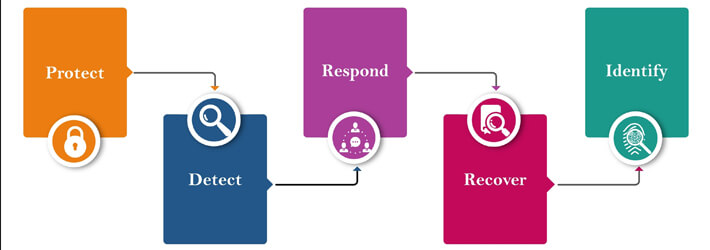Last Updated on October 16, 2023 by Satyendra

A cybersecurity framework is a set of documents that provide guidelines and best practices to help organizations protect their assets from cybersecurity threats. There are various cybersecurity frameworks to choose from such as ISO 27001, the Cybersecurity maturity model (CMMC) developed by the US Department of Defense (DoD), and the Payment Card Industry Data Security Standard (PCI DSS), to name a few. However, this article will focus on the National Institute of Standards and Technology Cybersecurity Framework (NIST CSF).
Originally, the NIST CSF was designed to secure critical infrastructure in the United States, but it is now recognized as applicable to any organization looking to bolster their cybersecurity.
NIST Cybersecurity Framework Elements
The NIST Cybersecurity Framework includes five core components; Identify, Protect, Detect, Respond, and Recover, which are explained in more detail below.
1. Identify
The ‘Identify’ component of the NIST CSF involves determining the valuable assets within the organization and understanding their associated risks (also known as NIST asset management). The key actions during this phase include:
Asset management: Identify the physical and software assets present in the organization in order to establish an asset management program. This enables the organization to determine which assets are relevant to the subsequent elements of the IT security framework.
Assessment of critical business assets: Determine the business environment supported by the organization and how its offerings relate to the required standards when participating in securing critical business assets within the supply chain.
Governance and compliance policies: Identify cybersecurity policies implemented by the organization to establish its governance program and to ensure compliance with regulatory requirements regarding cybersecurity.
Identifying vulnerabilities and threats: Identify vulnerabilities and threats to both internal and external resources, as well as establishing acceptable levels of risk for specific threat scenarios.
Supply chain risk management strategy: Determine a strategy for managing supply chain risks, which includes defining priorities, constraints, risk tolerances, and assumptions that guide decision-making in relation to supply chain risks.
2. Protect
The ‘Protect’ component of the NIST CSF involves safeguarding critical business assets from cybersecurity risks. This involves implementing measures such as security controls to protect crucial services and prevent unauthorized access to sensitive data. The essential actions to be taken during this phase include:
Ensuring a robust IAM strategy: Identity and Access Management (IAM) will help to minimize the exposure of sensitive information within the organization.
Security awareness training: Create security awareness training programs to educate and empower staff members within the organization, while emphasizing the distinctions between privileged and non-privileged users.
Ensuring the confidentiality, integrity, and availability of information: This will help organizations implement data security measures that are aligned with their risk strategy – potentially based on the NIST impact levels.
Implementing data protection processes and procedures: This will help to sustain the integrity of information systems and safeguard critical assets.
3. Detect
The ‘Detect’ component of the NIST CSF involves identifying cybersecurity incidents in real-time. This involves setting up monitoring and detection systems that can notify the organization of potential threats and allow for quick responses. The procedures established during this phase determine the level of proactive threat detection within the organization. The key tasks during this stage include:
- Developing procedures based on the NIST framework to ensure the detection of anomalies and other meaningful events, as well as understanding the potential impact of each event.
- Evaluating the effectiveness of existing protective measures and implementing new capabilities to enhance the monitoring of cybersecurity incidents and ensure the organization can protect, detect, and respond to suspicious activities promptly.
- Assessing current processes and maintaining detection procedures to provide the organization with alerts and visibility when unusual events occur.
4. Respond
The ‘Respond’ component of the NIST Cybersecurity Framework involves promptly addressing cybersecurity incidents as they arise. This entails having a clearly defined plan in place for responding to and escalating incidents, ensuring the organization can effectively recover. This component also enables the organization to swiftly and efficiently resolve issues and minimize potential harm in the event of an attack. The following activities should occur during this phase:
- Ensuring that response planning processes are ready to be implemented during and after an incident occurs, mitigating and investigating any potential harm caused by the incident.
- Establishing communication protocols with relevant stakeholders, including law enforcement and external partners, to effectively manage communications during and after the event.
- Implementing an analysis plan to guarantee an efficient response and support recovery efforts, which may involve forensic analysis and assessing the impact of incidents.
5. Recover
The fifth and final component of the NIST CSF focuses on recovering from a cybersecurity incident. This involves implementing measures to restore normal operations and minimize the impact of the incident on the organization. The efforts made by an organization in the recovery phase will directly influence their ability to control the impact of a cybersecurity incident and reduce potential harm. While this component is separate from the Protect, Detect, Respond triad, it is one of the most crucial functions of NIST as it determines the extent of damage a cybersecurity incident can inflict on an organization. The essential activities that should occur during this phase are:
Ensuring the implementation of recovery planning processes: This includes establishing system restoration procedures to mitigate the consequences of a cybersecurity incident.
Continually review existing strategies: Continuously learning and improving recovery strategies based on industry standards and previous cybersecurity incidents.
Communicating with stakeholders: This involves planning the coordination of internal and external communications during and after the recovery from a cybersecurity incident.
How Lepide Can Help
The Lepide Data Security Platform can detect and respond to threats to your sensitive data. It can help you effectively govern access to your sensitive data by identifying users with excessive permissions and applying appropriate access controls. Furthermore, with visibility over your sensitive data, you can spot risky user behavior and receive alerts and reports on behavior that may put your data at risk. Below are some of the most notable ways that the Lepide Data Security Platform can help you fulfil the requirements of the NIST Cybersecurity Framework:
Identify: Lepide offers a data discovery and classification feature that allows you to easily locate sensitive data in your unstructured data stores and classify the data in alignment with the NIST CSF guidelines. You can also identify sensitive data at the point of creation, ensuring that you can take prompt action to protect it. Additionally, our platform provides insights into the data users can access, allowing you to make informed decisions regarding how to classify and protect it.
Protect: Our solution allows you to accurately determine the number of privileged users within your organization. It enables you to track their engagements with sensitive information and receive immediate notifications of any abnormal user activities. It allows you can oversee logon/logoff activities and manage password resets via an intuitive dashboard. With Lepide Active Directory Cleanup, you can simplify the process of keeping Active Directory clean, without needing to involve IT staff. It eliminates inactive and obsolete accounts on a regular basis through automated actions like deleting, disabling or moving them to another organizational unit.
Detect: Lepide helps you detect unusual user behavior, which might include actions like transferring sensitive files, accessing the server outside of normal hours, or any other deviations from established patterns. Pre-configured threat models are capable of recognizing various known security threats and will promptly notify you once a threat is detected in your critical systems. By linking events across multiple systems and data repositories, potential threats can be identified based on specific attack paths. Lepide will help you maintain data protection and compliance by receiving real-time alerts when specific conditions, such as a high volume of file copy events within a short period, are met.
Respond: Lepide uses advanced machine learning algorithms to analyze user behavior and detect anomalies in real-time. By collecting and correlating vast amounts of data from various sources, Lepide can quickly identify potential threats and flag them for further investigation. Additionally, Lepide provides insights into the root cause of the security incident by providing a comprehensive timeline of events and highlighting the exact actions taken by the attacker. As such, Lepide can play a crucial role in conducting a thorough forensic analysis after a security incident.
Recover: The Lepide Data Security Platform allows administrators to easily roll back unauthorized or unwanted changes made to Active Directory and Group Policy. By using the Object Restore Wizard, users can revert these changes back to their original state with just a few clicks. The platform also captures backup snapshots of these objects, allowing users to store them externally for future restoration. Additionally, the platform provides audit reports that display all changes made, making it easy to identify and reverse specific changes if necessary.
If you’d like to see how the Lepide Data Security Platform can help you fulfil the core requirements of the NIST CSF, schedule a demo with one of our engineers.


